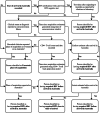A population-level application of a method for estimating the timing of HIV acquisition among migrants to Australia
- PMID: 37317678
- PMCID: PMC10267571
- DOI: 10.1002/jia2.26127
A population-level application of a method for estimating the timing of HIV acquisition among migrants to Australia
Abstract
Introduction: Australia has set the goal for the virtual elimination of HIV transmission by the end of 2022, yet accurate information is lacking on the level of HIV transmission occurring among residents. We developed a method for estimating the timing of HIV acquisition among migrants, relative to their arrival in Australia. We then applied this method to surveillance data from the Australian National HIV Registry with the aim of ascertaining the level of HIV transmission among migrants to Australia occurring before and after migration, and to inform appropriate local public health interventions.
Methods: We developed an algorithm incorporating CD4+ T-cell decline back-projection and enhanced variables (clinical presentation, past HIV testing history and clinician estimate of the place of HIV acquisition) and compared it to a standard algorithm which uses CD4+ T-cell back-projection only. We applied both algorithms to all new HIV diagnoses among migrants to estimate whether HIV infection occurred before or after arrival in Australia.
Results: Between 1 January 2016 and 31 December 2020, 1909 migrants were newly diagnosed with HIV in Australia, 85% were men, and the median age was 33 years. Using the enhanced algorithm, 932 (49%) were estimated to have acquired HIV after arrival in Australia, 629 (33%) before arrival (from overseas), 250 (13%) close to arrival and 98 (5%) were unable to be classified. Using the standard algorithm, 622 (33%) were estimated to have acquired HIV in Australia, 472 (25%) before arrival, 321 (17%) close to arrival and 494 (26%) were unable to be classified.
Conclusions: Using our algorithm, close to half of migrants diagnosed with HIV were estimated to have acquired HIV after arrival in Australia, highlighting the need for tailored culturally appropriate testing and prevention programmes to limit HIV transmission and achieve elimination targets. Our method reduced the proportion of HIV cases unable to be classified and can be adopted in other countries with similar HIV surveillance protocols, to inform epidemiology and elimination efforts.
Keywords: HIV epidemiology; HIV prevention; key and vulnerable populations; men who have sex with men; public health; sexually transmitted infections/diseases.
© 2023 The Authors. Journal of the International AIDS Society published by John Wiley & Sons Ltd on behalf of the International AIDS Society.
Conflict of interest statement
The authors declare no competing interests.
Figures
References
-
- Joint United Nations Programme on HIV/AIDS (UNAIDS). The Gap Report. Geneva; 2014.
-
- Australian Government . Eighth National HIV Strategy 2018–2022. Canberra, Australia; 2018.
-
- King J, Naruka E, Thomas J, McManus H, McGregor S. Bloodborne viral and sexually transmissible infections in Aboriginal and Torres Strait Islander people. Annual Surveillance Report 2022. Sydney, Australia: Kirby Institute, UNSW Sydney; 2022.
-
- Public Health England . HIV: annual data tables [Internet]. GOV.UK. [cited 2021 Jul 9]. Available from: https://www.gov.uk/government/statistics/hiv‐annual‐data‐tables
-
- Jamil MS, Prestage G, Fairley CK, Grulich AE, Smith KS, Chen M, et al. Effect of availability of HIV self‐testing on HIV testing frequency in gay and bisexual men at high risk of infection (FORTH): a waiting‐list randomised controlled trial. Lancet HIV. 2017;4(6):e241–50. - PubMed
MeSH terms
LinkOut - more resources
Full Text Sources
Medical
Research Materials
Miscellaneous



